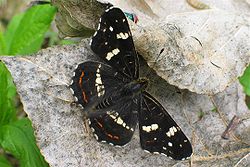.gif)
Map (butterfly)
Encyclopedia
The Map is a butterfly
of the Nymphalidae
family. It is common throughout the lowlands of central and eastern Europe
, and is expanding its range in western Europe.
 In the UK this species is a very rare vagrant, but there have also been several unsuccessful – and now illegal – attempts at introducing this species over the past 100 years or so: in the Wye Valley in 1912, the Wyre Forest in the 1920s, South Devon 1942, Worcester 1960s, Cheshire 1970s, South Midlands 1990s. All these introductions failed and eggs or larvae have never been recorded in the wild in the UK. (Under the Wildlife and Countryside Act 1981
In the UK this species is a very rare vagrant, but there have also been several unsuccessful – and now illegal – attempts at introducing this species over the past 100 years or so: in the Wye Valley in 1912, the Wyre Forest in the 1920s, South Devon 1942, Worcester 1960s, Cheshire 1970s, South Midlands 1990s. All these introductions failed and eggs or larvae have never been recorded in the wild in the UK. (Under the Wildlife and Countryside Act 1981
it is now illegal to release a non-native species into the wild.)
The Map is unusual in that its two annual broods look very different. The summer brood are black with white markings, looking like a miniature version of the White Admiral
and lacking most of the orange of the pictured spring brood.
The eggs are laid in long strings, one on top of the other, on the underside of stinging nettle
s, the larval foodplant. It is thought that these strings of eggs mimic the flowers of the nettles, thereby evading predators. The larvae feed gregariously and hibernate
as pupae.
Butterfly
A butterfly is a mainly day-flying insect of the order Lepidoptera, which includes the butterflies and moths. Like other holometabolous insects, the butterfly's life cycle consists of four parts: egg, larva, pupa and adult. Most species are diurnal. Butterflies have large, often brightly coloured...
of the Nymphalidae
Nymphalidae
The Nymphalidae is a family of about 5,000 species of butterflies which are distributed throughout most of the world. These are usually medium sized to large butterflies. Most species have a reduced pair of forelegs and many hold their colourful wings flat when resting. They are also called...
family. It is common throughout the lowlands of central and eastern Europe
Europe
Europe is, by convention, one of the world's seven continents. Comprising the westernmost peninsula of Eurasia, Europe is generally 'divided' from Asia to its east by the watershed divides of the Ural and Caucasus Mountains, the Ural River, the Caspian and Black Seas, and the waterways connecting...
, and is expanding its range in western Europe.

Wildlife and Countryside Act 1981
The Wildlife and Countryside Act 1981 is an Act of Parliament in the United Kingdom and was implemented to comply with the Directive 2009/147/EC on the conservation of wild birds...
it is now illegal to release a non-native species into the wild.)
The Map is unusual in that its two annual broods look very different. The summer brood are black with white markings, looking like a miniature version of the White Admiral
Limenitis camilla
The White Admiral, Limenitis camilla, is a butterfly of the Nymphalidae family. They are found in woodland throughout southern Britain and much of Europe and Asia, extending as far east as Japan....
and lacking most of the orange of the pictured spring brood.
The eggs are laid in long strings, one on top of the other, on the underside of stinging nettle
Stinging nettle
Stinging nettle or common nettle, Urtica dioica, is a herbaceous perennial flowering plant, native to Europe, Asia, northern Africa, and North America, and is the best-known member of the nettle genus Urtica...
s, the larval foodplant. It is thought that these strings of eggs mimic the flowers of the nettles, thereby evading predators. The larvae feed gregariously and hibernate
Hibernation
Hibernation is a state of inactivity and metabolic depression in animals, characterized by lower body temperature, slower breathing, and lower metabolic rate. Hibernating animals conserve food, especially during winter when food supplies are limited, tapping energy reserves, body fat, at a slow rate...
as pupae.

